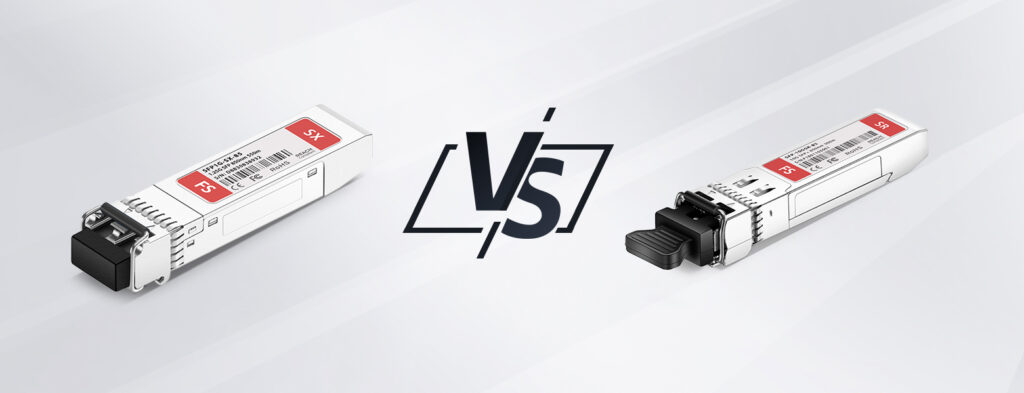The rapid adoption of the 10G-25G upgrade path has spurred the development of 10/25G dual rate fiber optics, offering a simpler solution to accommodate the prevailing migration trend in contemporary Ethernet networks.
Challenges in Transitioning from 10G to 25G Network
25Gbps has been deemed a cost-effective and minimally disruptive method for upgrading from 10Gbps to the higher speed of 100Gbps by numerous forward-thinking enterprises and data centres. Over recent years, there has been a remarkable surge in the 25Gbps market and the technological significance of deploying 25G networks. Nonetheless, the transition from 10G to 25G may present supplementary challenges.
The commonly utilised transceiver modules typically support a single rate, such as 10G SFP+ transceivers and 25G SFP28 transceivers. Given that both ends of a 10G-25G link necessitate simultaneous upgrading, transitioning from 10G to 25G networks entails replacing the entire transceiver and cable infrastructure, leading to significant costs in capital expenditure, time, and energy.
To tackle the challenges encountered in the migration path from 10G to 25G, dual-rate transceivers supporting both 10G and 25G are being introduced.
10/25G Dual Rate Transceiver – Solution to 10G-25G Network
Dual-rate transceivers, often referred to as multi-rate transceivers, denote a type of optical transceiver that supports dual rates, as opposed to the commonly used single-rate transceivers. As the name suggests, 10/25G dual-rate transceivers accommodate two rates – 10Gbps and 25Gbps. In terms of appearance, the dual-rate transceiver resembles a 25G single-rate transceiver – both conform to the SFP28 form factor.
However, the dual-rate transceivers are compatible with either 10G SFP+ ports or 25G SFP28 ports, making them more versatile than single-rate transceivers. Furthermore, when employed with a breakout cable, they have the capability to operate with 40G/100G networks.
The ensuing chart will juxtapose 10/25G dual rate optical transceivers with 10G/25G single-rate transceivers, utilizing the FS 10/25GBASE-SR transceiver as a reference.
| Transceiver Type | Max. Data Rate | Max. Cable Distance | Clock and Data Recovery (CDR) | Compatibility With SFP+ Port | Compatibility With SFP28 Port@10G | Compatibility With SFP28 Port@25G |
| 10/25G SR Transceiver | 10Gbps and 25.78Gbps | 100m @ OM4 MMF, 70m @ OM3 MMF | TX & RX Built-in CDR Supported | Y | Y | Y |
| 10G SFP+ SR Transceiver | 10.3125Gbps | 400m@OM4 300m@OM3 | N | Y | Y | N |
| 25G SFP28 SR Transceiver | 25.78Gbps | 100m @ OM4 MMF, 70m @ OM3 MMF | TX & RX Built-in CDR Supported | N | N | Y |
Apart from dual rate transceivers in SFP28 transceivers, there are also other dual rate transceivers with different form factors and data rates such as dual rate SFP+ transceivers supporting 100M/1000Mbps data rates.
Advantages of 10/25G Dual Rate Transceiver
10/25G dual rate optical transceivers include advantages as follows:
Backwards Forward Compatibility
As previously mentioned, 10/25G dual rate transceivers are compatible with either 10G SFP+ ports or 25G SFP28 ports. They can be configured to operate at either 10G or 25G, depending on the switch ports’ support.
Future-Proofed Networking
For those deploying a 10G network without an immediate need to upgrade to 25G, utilizing dual rate SFP28 transceivers future-proofs the network. This makes it easier to upgrade the network whenever necessary without requiring new infrastructure.
Protection of Investments
The functionality of a 10/25G dual rate transceiver combines that of a 10G SFP+ transceiver and a 25G SFP28 transceiver. There is no need to change cables or transceivers when upgrading from 10G to 25G network, thus minimizing upgrade costs. Moreover, for network operators reluctant to upgrade the entire 10G network infrastructure at once, dual rate transceivers present a cost-effective solution.
Streamlined Network Upgrades
Implementing 10/25G dual rate transceivers eliminates the complexity associated with changing transceiver modules and cables. This saves significant time and effort for network operators, particularly in high-density data centres where altering a wide range of deployments can be cumbersome.
Dual Rate Transceiver Application for 25G Network
10/25G dual rate transceivers can be used to replace single rate 10G or 25G transceivers in data centres or enterprises, connecting distribution switches to access switches, ToR, MoR, EoR switches to servers or leaf switches based on the transmission distance they allow.
As the figure shows, when the switches are upgraded from 10G to 25G switches, the dual rate transceivers and cables need no change or addition, which helps to upgrade from 10G network to 25G network seamlessly. Whether in data centres or enterprises, when network operators are deploying 10G networks but require future migration from 10G to 25G, the 10/25G dual rate transceiver can help the deployment with its 10G/25G dual rate capability.
FS.com supports 10G/25G dual rate transceiver portfolio and network switches that support dual rate transceivers such as S5860-20SQ switch with 10G/25G SFP28 dual rate ports for multiple uses in 10G or 25G Ethernet networks.
Related Articles:
How to Select the Optimal SFP-10G-SR Module for Diverse Networking Environments








